花青素计算法
- 格式:pdf
- 大小:2.57 MB
- 文档页数:8
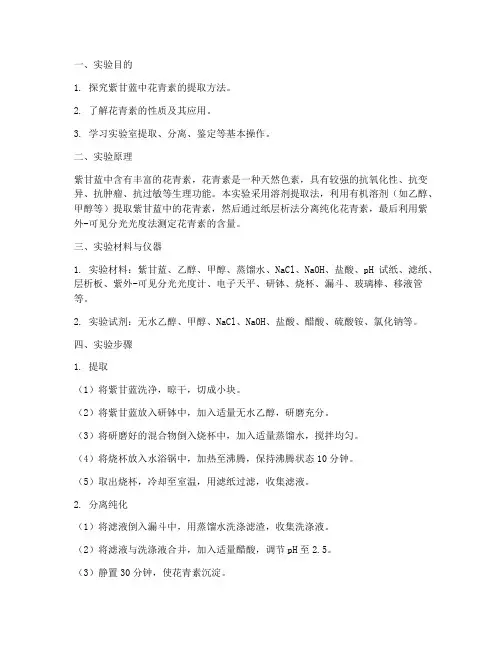
一、实验目的1. 探究紫甘蓝中花青素的提取方法。
2. 了解花青素的性质及其应用。
3. 学习实验室提取、分离、鉴定等基本操作。
二、实验原理紫甘蓝中含有丰富的花青素,花青素是一种天然色素,具有较强的抗氧化性、抗变异、抗肿瘤、抗过敏等生理功能。
本实验采用溶剂提取法,利用有机溶剂(如乙醇、甲醇等)提取紫甘蓝中的花青素,然后通过纸层析法分离纯化花青素,最后利用紫外-可见分光光度法测定花青素的含量。
三、实验材料与仪器1. 实验材料:紫甘蓝、乙醇、甲醇、蒸馏水、NaCl、NaOH、盐酸、pH试纸、滤纸、层析板、紫外-可见分光光度计、电子天平、研钵、烧杯、漏斗、玻璃棒、移液管等。
2. 实验试剂:无水乙醇、甲醇、NaCl、NaOH、盐酸、醋酸、硫酸铵、氯化钠等。
四、实验步骤1. 提取(1)将紫甘蓝洗净,晾干,切成小块。
(2)将紫甘蓝放入研钵中,加入适量无水乙醇,研磨充分。
(3)将研磨好的混合物倒入烧杯中,加入适量蒸馏水,搅拌均匀。
(4)将烧杯放入水浴锅中,加热至沸腾,保持沸腾状态10分钟。
(5)取出烧杯,冷却至室温,用滤纸过滤,收集滤液。
2. 分离纯化(1)将滤液倒入漏斗中,用蒸馏水洗涤滤渣,收集洗涤液。
(2)将滤液与洗涤液合并,加入适量醋酸,调节pH至2.5。
(3)静置30分钟,使花青素沉淀。
(4)取上层清液,用滤纸过滤,收集滤液。
(5)将滤液倒入烧杯中,加入适量硫酸铵,搅拌,使蛋白质沉淀。
(6)静置30分钟,取上层清液,用滤纸过滤,收集滤液。
3. 测定花青素含量(1)取适量滤液,用紫外-可见分光光度计测定其在520nm处的吸光度。
(2)根据标准曲线计算花青素含量。
五、实验结果与分析1. 提取结果:紫甘蓝提取液呈紫色,说明花青素已被成功提取。
2. 分离纯化结果:滤液经过分离纯化后,颜色较浅,说明花青素得到了一定的纯化。
3. 花青素含量测定结果:根据标准曲线计算,紫甘蓝提取液中花青素含量为0.5mg/g。
六、实验结论1. 紫甘蓝中花青素可以通过溶剂提取法提取。
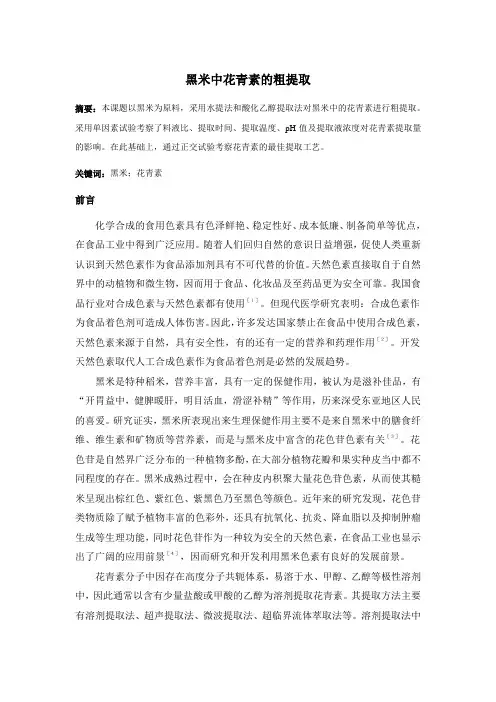
黑米中花青素的粗提取摘要:本课题以黑米为原料,采用水提法和酸化乙醇提取法对黑米中的花青素进行粗提取。
采用单因素试验考察了料液比、提取时间、提取温度、pH值及提取液浓度对花青素提取量的影响。
在此基础上,通过正交试验考察花青素的最佳提取工艺。
关键词:黑米;花青素前言化学合成的食用色素具有色泽鲜艳、稳定性好、成本低廉、制备简单等优点,在食品工业中得到广泛应用。
随着人们回归自然的意识日益增强,促使人类重新认识到天然色素作为食品添加剂具有不可代替的价值。
天然色素直接取自于自然界中的动植物和微生物,因而用于食品、化妆品及至药品更为安全可靠。
我国食品行业对合成色素与天然色素都有使用[1]。
但现代医学研究表明:合成色素作为食品着色剂可造成人体伤害。
因此,许多发达国家禁止在食品中使用合成色素,天然色素来源于自然,具有安全性,有的还有一定的营养和药理作用[2]。
开发天然色素取代人工合成色素作为食品着色剂是必然的发展趋势。
黑米是特种稻米,营养丰富,具有一定的保健作用,被认为是滋补佳品,有“开胃益中,健脾暖肝,明目活血,滑涩补精”等作用,历来深受东亚地区人民的喜爱。
研究证实,黑米所表现出来生理保健作用主要不是来自黑米中的膳食纤维、维生素和矿物质等营养素,而是与黑米皮中富含的花色苷色素有关[3]。
花色苷是自然界广泛分布的一种植物多酚,在大部分植物花瓣和果实种皮当中都不同程度的存在。
黑米成熟过程中,会在种皮内积聚大量花色苷色素,从而使其糙米呈现出棕红色、紫红色、紫黑色乃至黑色等颜色。
近年来的研究发现,花色苷类物质除了赋予植物丰富的色彩外,还具有抗氧化、抗炎、降血脂以及抑制肿瘤生成等生理功能,同时花色苷作为一种较为安全的天然色素,在食品工业也显示出了广阔的应用前景[4],因而研究和开发利用黑米色素有良好的发展前景。
花青素分子中因存在高度分子共轭体系,易溶于水、甲醇、乙醇等极性溶剂中,因此通常以含有少量盐酸或甲酸的乙醇为溶剂提取花青素。
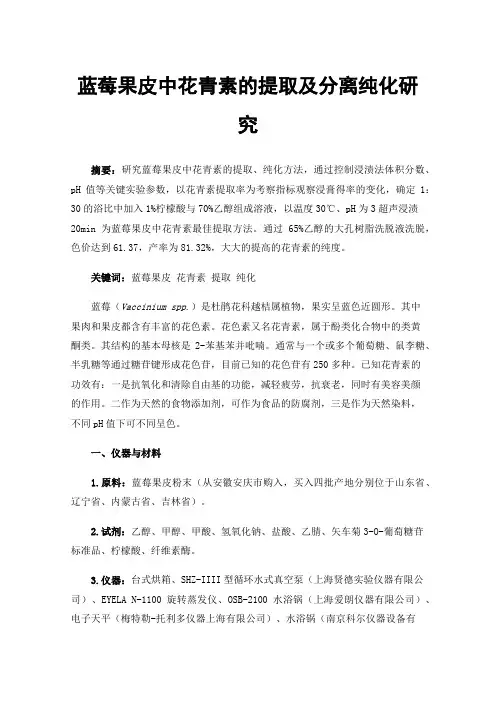
蓝莓果皮中花青素的提取及分离纯化研究摘要:研究蓝莓果皮中花青素的提取、纯化方法,通过控制浸渍法体积分数、pH值等关键实验参数,以花青素提取率为考察指标观察浸膏得率的变化,确定1:30的浴比中加入1%柠檬酸与70%乙醇组成溶液,以温度30℃、pH为3超声浸渍20min为蓝莓果皮中花青素最佳提取方法。
通过65%乙醇的大孔树脂洗脱液洗脱,色价达到61.37,产率为81.32%,大大的提高的花青素的纯度。
关键词:蓝莓果皮花青素提取纯化蓝莓(Vaccinium spp.)是杜鹃花科越桔属植物,果实呈蓝色近圆形。
其中果肉和果皮都含有丰富的花色素。
花色素又名花青素,属于酚类化合物中的类黄酮类。
其结构的基本母核是2-苯基苯并吡喃。
通常与一个或多个葡萄糖、鼠李糖、半乳糖等通过糖苷键形成花色苷,目前已知的花色苷有250多种。
已知花青素的功效有:一是抗氧化和清除自由基的功能,减轻疲劳,抗衰老,同时有美容美颜的作用。
二作为天然的食物添加剂,可作为食品的防腐剂,三是作为天然染料,不同pH值下可不同呈色。
一、仪器与材料1.原料:蓝莓果皮粉末(从安徽安庆市购入,买入四批产地分别位于山东省、辽宁省、内蒙古省、吉林省)。
2.试剂:乙醇、甲醇、甲酸、氢氧化钠、盐酸、乙腈、矢车菊3-O-葡萄糖苷标准品、柠檬酸、纤维素酶。
3.仪器:台式烘箱、SHZ-IIII型循环水式真空泵(上海贤德实验仪器有限公司)、EYELA N-1100旋转蒸发仪、OSB-2100水浴锅(上海爱朗仪器有限公司)、电子天平(梅特勒-托利多仪器上海有限公司)、水浴锅(南京科尔仪器设备有限公司)、SB-3200D超声波清洗仪(宁波新芝生物科技股份有限公司),Agilent 1100 高效液相色谱仪、紫外可见分光光度计(Thermo)、层析柱、AB-8大孔树脂、各个型号圆底烧瓶等玻璃仪器。
二、蓝莓果皮中花色素的提取1.提取方法:花色素分子含有酸性与碱性基团,溶于水和乙醇等醇类化合物。
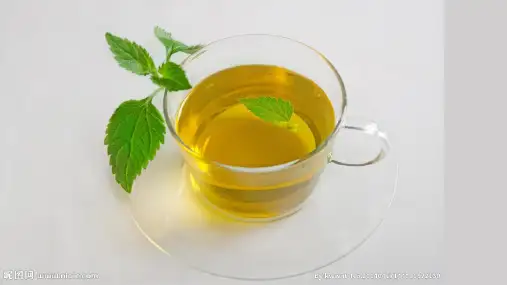
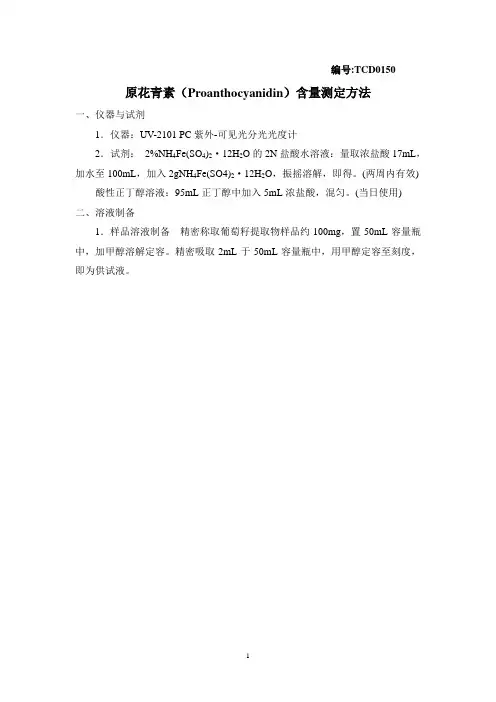
编号:TCD0150 原花青素(Proanthocyanidin)含量测定方法
一、仪器与试剂
1.仪器:UV-2101 PC紫外-可见光分光光度计
2.试剂:2%NH4Fe(SO4)2·12H2O的2N盐酸水溶液:量取浓盐酸17mL,加水至100mL,加入2gNH4Fe(SO4)2·12H2O,振摇溶解,即得。
(两周内有效) 酸性正丁醇溶液:95mL正丁醇中加入5mL浓盐酸,混匀。
(当日使用)
二、溶液制备
1.样品溶液制备精密称取葡萄籽提取物样品约100mg,置50mL容量瓶中,加甲醇溶解定容。
精密吸取2mL于50mL容量瓶中,用甲醇定容至刻度,即为供试液。
精密吸取该供试液1mL于10mL具塞试管中,加入2% NH4Fe(SO4)2·12H2O 的2N盐酸水溶液0.2mL,酸性正丁醇溶液6mL,拧紧密封盖,摇匀,拧松密封盖。
置95℃水浴中加热反应60min,取出,在冰水浴中快速冷却,即得待测样品溶液。
2.标准品溶液制备以标准样品代替样品,按样品溶液制备方法,处理即得标准品溶液。
3.样品空白溶液制备以甲醇代替样品供试液,按样品溶液处理,即得空白溶液。
三、样品测定
打开仪器电源,预热20min,待仪器自检通过后,在546nm处以样品空白溶液作为空白,测定标准品溶液和样品溶液吸收度。
四、结果计算
A×Ws
C%= ×S
As×W
As、A:标准样品、样品吸收值
Ws、W:标准样品、样品称样量(mg)
S:标准样品含量(%)
注:所用器皿均需干燥处理。
除甲醇外,其余均需平行显色三份。
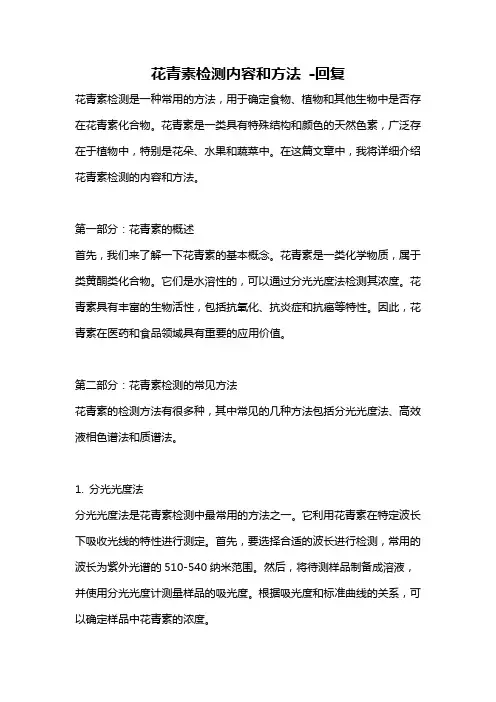
花青素检测内容和方法-回复花青素检测是一种常用的方法,用于确定食物、植物和其他生物中是否存在花青素化合物。
花青素是一类具有特殊结构和颜色的天然色素,广泛存在于植物中,特别是花朵、水果和蔬菜中。
在这篇文章中,我将详细介绍花青素检测的内容和方法。
第一部分:花青素的概述首先,我们来了解一下花青素的基本概念。
花青素是一类化学物质,属于类黄酮类化合物。
它们是水溶性的,可以通过分光光度法检测其浓度。
花青素具有丰富的生物活性,包括抗氧化、抗炎症和抗癌等特性。
因此,花青素在医药和食品领域具有重要的应用价值。
第二部分:花青素检测的常见方法花青素的检测方法有很多种,其中常见的几种方法包括分光光度法、高效液相色谱法和质谱法。
1. 分光光度法分光光度法是花青素检测中最常用的方法之一。
它利用花青素在特定波长下吸收光线的特性进行测定。
首先,要选择合适的波长进行检测,常用的波长为紫外光谱的510-540纳米范围。
然后,将待测样品制备成溶液,并使用分光光度计测量样品的吸光度。
根据吸光度和标准曲线的关系,可以确定样品中花青素的浓度。
2. 高效液相色谱法高效液相色谱法(HPLC)是一种精确测定花青素浓度的分析方法。
它利用花青素在特定条件下与色谱柱相互作用的特性进行分离和测定。
在HPLC方法中,样品经过前处理后注入色谱柱,通过流动相不同的组成进行分离。
然后,使用紫外检测器检测样品中花青素的峰值,并根据峰面积和标准曲线的关系确定含量。
3. 质谱法质谱法是一种高灵敏度和高分辨率的分析技术,可用于花青素的定性和定量分析。
质谱法可以直接测定花青素分子的质量和结构。
通过质谱仪的扫描,可以得到花青素的质谱图,并通过比对已知标准品的质谱图进行分析。
第三部分:花青素检测的样品准备在进行花青素检测之前,需要对样品进行适当的预处理。
首先,要将样品磨碎或切碎,以提高样品暴露表面积。
然后,将样品加入适量的溶剂中,浸泡一段时间,以提取花青素。
提取液中的杂质可以通过滤纸或离心去除。
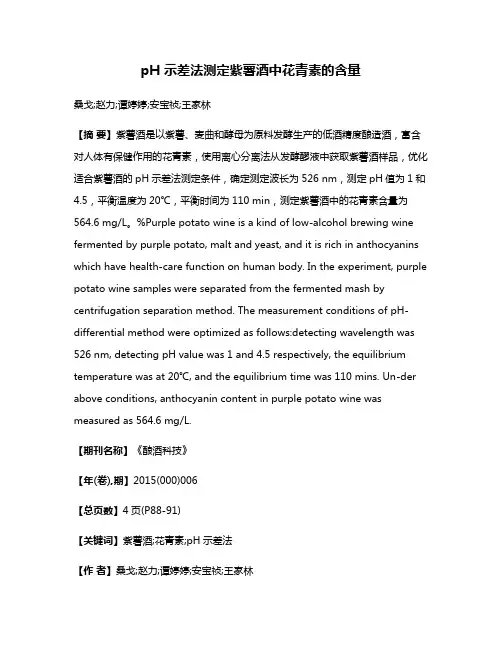
pH 示差法测定紫薯酒中花青素的含量桑戈;赵力;谭婷婷;安宝祯;王家林【摘要】紫薯酒是以紫薯、麦曲和酵母为原料发酵生产的低酒精度酿造酒,富含对人体有保健作用的花青素,使用离心分离法从发酵醪液中获取紫薯酒样品,优化适合紫薯酒的pH示差法测定条件,确定测定波长为526 nm,测定pH值为1和4.5,平衡温度为20℃,平衡时间为110 min,测定紫薯酒中的花青素含量为564.6 mg/L。
%Purple potato wine is a kind of low-alcohol brewing wine fermented by purple potato, malt and yeast, and it is rich in anthocyanins which have health-care function on human body. In the experiment, purple potato wine samples were separated from the fermented mash by centrifugation separation method. The measurement conditions of pH-differential method were optimized as follows:detecting wavelength was 526 nm, detecting pH value was 1 and 4.5 respectively, the equilibrium temperature was at 20℃, and the equilibrium time was 110 mins. Un-der above conditions, anthocyanin content in purple potato wine was measured as 564.6 mg/L.【期刊名称】《酿酒科技》【年(卷),期】2015(000)006【总页数】4页(P88-91)【关键词】紫薯酒;花青素;pH示差法【作者】桑戈;赵力;谭婷婷;安宝祯;王家林【作者单位】青岛科技大学生物工程实验室,山东青岛266042;青岛科技大学生物工程实验室,山东青岛266042;青岛科技大学生物工程实验室,山东青岛266042;青岛科技大学生物工程实验室,山东青岛266042;青岛科技大学生物工程实验室,山东青岛266042【正文语种】中文【中图分类】TS262.4;TS261.4;TS261.7紫薯酒是以紫薯、麦曲和酵母为主要原料,经过发酵、压榨过滤得到的低酒精度(14%vol左右)的酿造酒。
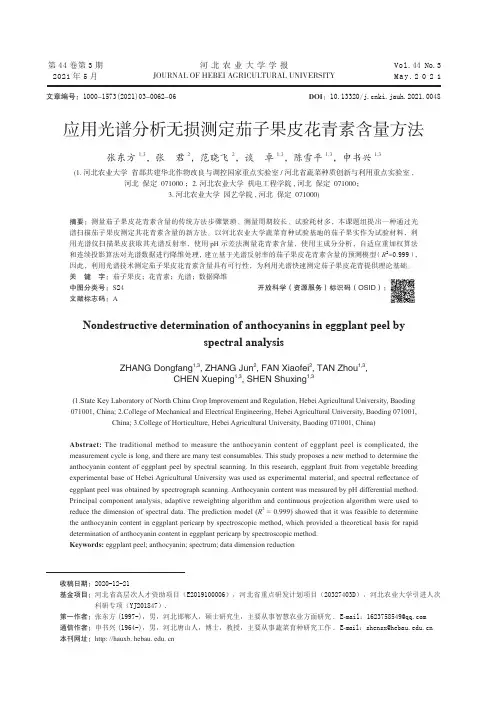
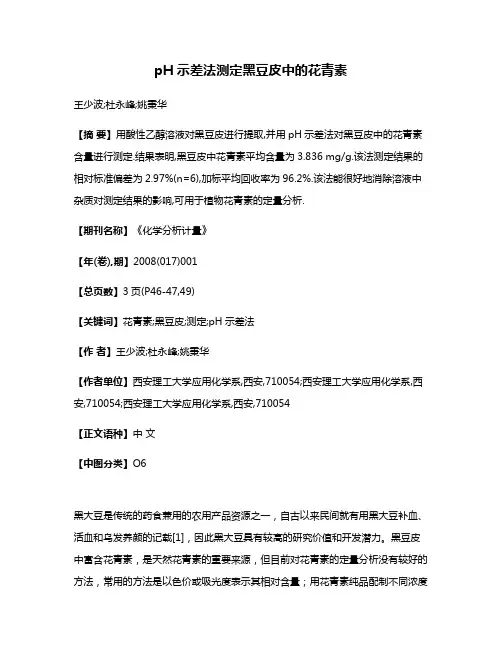
pH示差法测定黑豆皮中的花青素王少波;杜永峰;姚秉华【摘要】用酸性乙醇溶液对黑豆皮进行提取,并用pH示差法对黑豆皮中的花青素含量进行测定.结果表明,黑豆皮中花青素平均含量为3.836 mg/g.该法测定结果的相对标准偏差为2.97%(n=6),加标平均回收率为96.2%.该法能很好地消除溶液中杂质对测定结果的影响,可用于植物花青素的定量分析.【期刊名称】《化学分析计量》【年(卷),期】2008(017)001【总页数】3页(P46-47,49)【关键词】花青素;黑豆皮;测定;pH示差法【作者】王少波;杜永峰;姚秉华【作者单位】西安理工大学应用化学系,西安,710054;西安理工大学应用化学系,西安,710054;西安理工大学应用化学系,西安,710054【正文语种】中文【中图分类】O6黑大豆是传统的药食兼用的农用产品资源之一,自古以来民间就有用黑大豆补血、活血和乌发养颜的记载[1],因此黑大豆具有较高的研究价值和开发潜力。
黑豆皮中富含花青素,是天然花青素的重要来源,但目前对花青素的定量分析没有较好的方法,常用的方法是以色价或吸光度表示其相对含量;用花青素纯品配制不同浓度梯度绘制标准曲线测定花青素的含量,但由于花青素的标准品很不稳定,限制了这种方法的使用。
笔者采用pH示差法[2],结合T Fuleki 的研究[3]对黑豆皮中花青素进行了定量分析。
1 方法原理花青素发色团结构的转换是pH值的函数,而且起干扰作用的棕褐色(降解)产物的特征光谱不随pH值的改变而变化。
结合朗伯-比耳定律可得出,在两个不同的pH下,花青素溶液的吸光值的差值与花青素的含量成比例。
因此通过两个pH,同一波长(以花青素最大可见吸收波长)下的吸光值差值,参考T Fuleki 的经验公式便可以测得花青素的含量。
2 实验部分2.1 主要仪器与试剂紫外可见分光光度计:UV-1200型,上海美普达仪器有限公司;酸度计:pHS-3C型,上海康仪仪器有限公司;旋转蒸发仪:RE-52,上海嘉鹏科技有限公司;电子恒温水浴锅:天津市泰斯特仪器有限公司;pH 1.0缓冲溶液:0.2 mol/L KCl-0.2 mol/L HCl-H2O溶液,(体积比为50∶97∶53);pH 4.5缓冲溶液:准确称取19.294 g NaAc加入到24 mL冰乙酸中定容至500 mL。
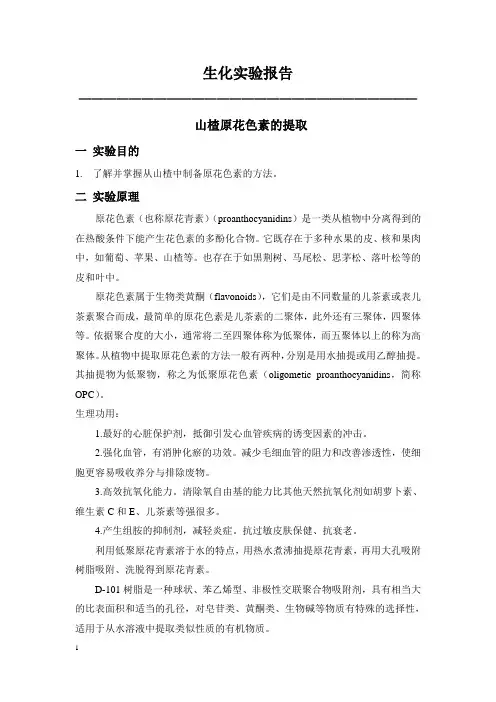
生化实验报告———————————————————————————山楂原花色素的提取一实验目的1.了解并掌握从山楂中制备原花色素的方法。
二实验原理原花色素(也称原花青素)(proanthocyanidins)是一类从植物中分离得到的在热酸条件下能产生花色素的多酚化合物。
它既存在于多种水果的皮、核和果肉中,如葡萄、苹果、山楂等。
也存在于如黒荆树、马尾松、思茅松、落叶松等的皮和叶中。
原花色素属于生物类黄酮(flavonoids),它们是由不同数量的儿茶素或表儿茶素聚合而成,最简单的原花色素是儿茶素的二聚体,此外还有三聚体,四聚体等。
依据聚合度的大小,通常将二至四聚体称为低聚体,而五聚体以上的称为高聚体。
从植物中提取原花色素的方法一般有两种,分别是用水抽提或用乙醇抽提。
其抽提物为低聚物,称之为低聚原花色素(oligometic proanthocyanidins,简称OPC)。
生理功用:1.最好的心脏保护剂,抵御引发心血管疾病的诱变因素的冲击。
2.强化血管,有消肿化瘀的功效。
减少毛细血管的阻力和改善渗透性,使细胞更容易吸收养分与排除废物。
3.高效抗氧化能力。
清除氧自由基的能力比其他天然抗氧化剂如胡萝卜素、维生素C和E、儿茶素等强很多。
4.产生组胺的抑制剂,减轻炎症。
抗过敏皮肤保健、抗衰老。
利用低聚原花青素溶于水的特点,用热水煮沸抽提原花青素,再用大孔吸附树脂吸附、洗脱得到原花青素。
D-101树脂是一种球状、苯乙烯型、非极性交联聚合物吸附剂,具有相当大的比表面积和适当的孔径,对皂苷类、黄酮类、生物碱等物质有特殊的选择性,适用于从水溶液中提取类似性质的有机物质。
三实验器材1. 新鲜山楂(或山楂片),市售。
2. 烧杯。
3. 高速组织粉碎机。
4. 玻璃层析柱1.5cm*20cm。
5. 大孔吸附树脂D-101。
6.电磁炉。
7. 不锈钢锅。
8.双层纱布。
四实验试剂1、95%乙醇(实验室提供)。
2、60%乙醇:取95%乙醇60ml,加入蒸馏水,使体积达到95ml。
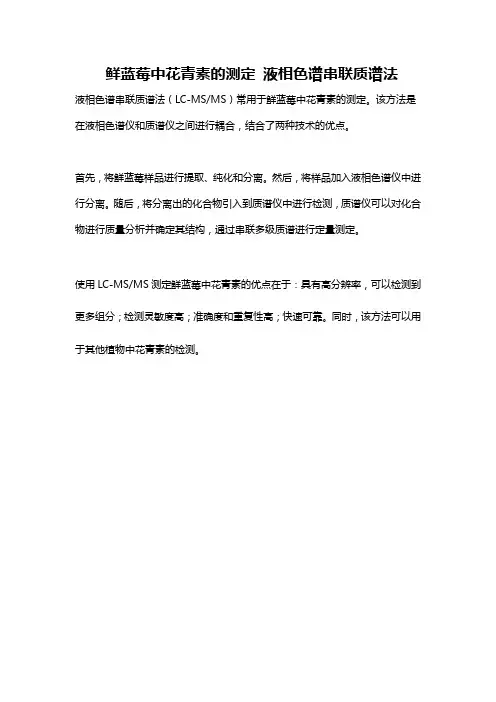
鲜蓝莓中花青素的测定液相色谱串联质谱法
液相色谱串联质谱法(LC-MS/MS)常用于鲜蓝莓中花青素的测定。
该方法是在液相色谱仪和质谱仪之间进行耦合,结合了两种技术的优点。
首先,将鲜蓝莓样品进行提取、纯化和分离。
然后,将样品加入液相色谱仪中进行分离。
随后,将分离出的化合物引入到质谱仪中进行检测,质谱仪可以对化合物进行质量分析并确定其结构,通过串联多级质谱进行定量测定。
使用LC-MS/MS测定鲜蓝莓中花青素的优点在于:具有高分辨率,可以检测到更多组分;检测灵敏度高;准确度和重复性高;快速可靠。
同时,该方法可以用于其他植物中花青素的检测。
茶叶中花青素测定方法研究进展及分光光度测定法的优化一、内容简述随着人们对健康生活方式的追求和对食品安全的关注,茶叶作为一种具有悠久历史和丰富文化内涵的饮品,其质量和安全性越来越受到广泛关注。
花青素作为茶叶中的重要活性成分,具有抗氧化、抗炎、抗癌等多种生物活性,因此对其含量的测定具有重要意义。
近年来茶叶中花青素测定方法研究取得了显著进展,其中分光光度法作为一种快速、准确、灵敏的分析方法,在茶叶中花青素测定方面发挥了重要作用。
本文将对茶叶中花青素测定方法研究的最新进展进行概述,并对分光光度法在茶叶中花青素测定过程中的优化进行探讨,以期为茶叶质量控制和安全评价提供科学依据。
1. 花青素的定义和分类花青素(Anthocyanin)是一类广泛存在于植物中的水溶性天然色素,具有多种生物活性,如抗氧化、抗炎、抗肿瘤等。
花青素主要分布在水果、蔬菜、茶叶等植物中,特别是在果实和花朵中含量较高。
花青素的化学结构多样,主要包括两大类:黄酮醇型花青素和花色苷型花青素。
黄酮醇型花青素包括花色苷、矢车菊红素、柚皮素等;花色苷型花青素包括红色花青素、蓝色花青素、紫色花青素等。
分光光度测定法是一种利用物质对特定波长的光吸收或透射来定量分析的方法。
在茶叶中花青素的测定过程中,分光光度测定法主要通过测量样品溶液在特定波长下的吸光度或透射率,结合已知浓度的标准溶液,计算出样品中花青素的浓度。
分光光度测定法具有操作简便、灵敏度高、重现性好等优点,因此在茶叶中花青素的测定领域得到了广泛应用。
2. 茶叶中花青素的重要性和应用价值茶叶中的花青素是一种具有重要生物活性的天然色素,其在茶叶中含量丰富,具有很高的营养价值和药用价值。
花青素具有抗氧化、抗炎、抗肿瘤、抗菌等多种生物活性,对人体健康具有重要的保健作用。
此外花青素还具有很好的美容效果,可以抑制皮肤衰老,减少皱纹使皮肤保持青春活力。
因此茶叶中花青素的研究和开发具有很大的经济和社会价值。
随着科学技术的发展,人们对茶叶中花青素的研究越来越深入。
硫酸香草醛法测定葡萄籽原花青素含量一、本文概述本文旨在探讨硫酸香草醛法在测定葡萄籽原花青素含量中的应用。
原花青素作为一种重要的天然抗氧化剂,在葡萄籽等植物中含量丰富,具有显著的生物活性,对人体健康具有积极作用。
因此,准确测定葡萄籽中原花青素的含量对于评估其营养价值和开发相关健康产品具有重要意义。
硫酸香草醛法作为一种常用的原花青素测定方法,具有操作简便、灵敏度高、重现性好等优点,在食品、药品等领域得到了广泛应用。
本文将详细介绍硫酸香草醛法的原理、操作步骤、影响因素及注意事项,并通过实验验证该方法的准确性和可靠性,为葡萄籽原花青素含量的测定提供科学依据。
二、材料与方法硫酸香草醛、葡萄籽提取物、原花青素标准品(纯度≥98%)、甲醇、乙醇、丙酮、盐酸等均为分析纯,购自国内外知名试剂公司。
紫外可见分光光度计、电子天平、恒温水浴锅、离心机、超声波清洗器等。
准确称取葡萄籽粉末适量,加入一定比例的甲醇-水-盐酸混合溶液,置于恒温水浴锅中进行回流提取。
提取液经过离心、过滤后,得到原花青素提取液。
精确称取原花青素标准品,用甲醇溶解并定容,得到不同浓度的标准溶液。
分别取各浓度标准溶液,加入硫酸香草醛试剂,摇匀后在一定温度下反应一定时间,测定其吸光度。
以吸光度为纵坐标,原花青素浓度为横坐标,绘制标准曲线。
取适量葡萄籽原花青素提取液,加入硫酸香草醛试剂,摇匀后在相同条件下进行反应,测定其吸光度。
根据标准曲线计算样品中原花青素的含量。
所有数据均以平均值±标准差表示,采用SPSS等统计软件进行数据分析,采用单因素方差分析(ANOVA)比较不同处理组之间的差异,显著性水平设为P<05。
通过以上方法和步骤,可以准确测定葡萄籽中原花青素的含量,为进一步研究葡萄籽的营养价值和开发利用提供依据。
三、实验结果与分析在本次研究中,我们采用硫酸香草醛法测定了葡萄籽原花青素含量。
此方法基于原花青素在特定条件下与硫酸香草醛发生显色反应,通过测定反应后溶液的光密度值,可推算出原花青素含量。
四种原花青素含量测定方法比较石磊; 高哲; 刘丽南; 韩巍; 杨晓博; 崔同【期刊名称】《《食品工业科技》》【年(卷),期】2019(040)015【总页数】7页(P242-247,253)【关键词】原花青素; 硫酸-香草醛法; 钼酸铵法; 正丁醇-盐酸-HPLC法; 硫解-HPLC【作者】石磊; 高哲; 刘丽南; 韩巍; 杨晓博; 崔同【作者单位】河北农业大学食品科技学院河北保定071000; 河北省保定市满城中学河北保定071000【正文语种】中文【中图分类】TS201.2原花色素(proanthocyanidins,PC)是一类以黄烷-3-醇为主要结构单元的缩合多酚类成分[1],存在于葡萄[2]、苹果[3]、山楂[4-5]、草莓[6]、莲[7]、高粱[8]、花生[9-10]、可可[11]等多种食用材料中,大量研究结果表明PC具有优越的抗氧化[12]、清除自由基、心血管保护等一系列重要的保健生理作用[13-15],自上世纪80年代以来,PC提取物已经成为功能性食品和化妆品的重要原料被广泛应用。
然而由于PC的组成和结构非常复杂[16],其相关产品的客观表征始终是困扰市场质量评价的技术难题[17],在国际上仍未形成统一的PC含量分析方法[18]。
常见的分析方法包括分光光度法和高效液相色谱(HPLC)法,前者如基于PC酸解生成花青素的Bate-Smith法[19]、丁醇-盐酸法(Porter法)[20]、芳香醛显色的硫酸-香草醛法[21]、PC还原反应的Folin-Ciocalteau法[22]以及钼酸铵法等[23],后者包括侧重多组分同时定量分析的直接HPLC法、侧重组分识别分析的LC-MS法[24]、经酸解生成花青素然后再经HPLC定量的国标分析方法[25],以及亲核试剂苄硫醇存在下PC裂解后分析其降解产物的硫解-HPLC法[26]。
这些方法的分析目的不同,定量分析原理不同,使用的对照(标准)品通常也不尽相同,经常会给出彼此矛盾的分析结果[27-28],而以往的文献未见有针对不同方法进行较系统的评价和比较。
花青素检测内容和方法花青素是一类存在于植物中的天然化合物,主要包括类黄酮和花色素。
它们在植物生长和发育过程中起着重要的作用,同时也赋予了植物丰富多彩的颜色。
花青素不仅是植物界的重要色素,在医学和食品工业中也有广泛的应用。
因此,准确地检测花青素成分以及其含量是很重要的。
本文将介绍花青素检测的内容和方法。
花青素的检测内容主要包括两个方面:一是对花青素种类进行鉴定和分析,二是对花青素的含量进行测定。
花青素种类的鉴定和分析是通过不同的分析技术来实现的,包括高效液相色谱法、气相色谱法、质谱法等。
这些技术能够对花青素分子的结构进行分析,确定其种类和含量。
而花青素的含量测定则是通过比色法、分光光度法、高效液相色谱法等方法来实现的。
花青素的含量测定是花青素分析的重要环节之一。
其中,比色法是最常用的一种方法。
它基于花青素的分子结构中具有强吸收光谱特性的特点,通过测定花青素溶液的吸光度来确定其含量。
这种方法简单、快速、准确,适用于大多数花青素的含量测定。
分光光度法也是常用的一种方法,通过比较样品与对照样品的吸光度来确定花青素的含量。
这种方法对样品要求较高,但具有较高的灵敏度和准确性。
而高效液相色谱法是一种较为复杂的方法,它通过测定样品中花青素的相对峰面积来计算花青素的含量。
这种方法适用于含有多种花青素的样品,对花青素种类和含量的鉴定和测定更为准确。
花青素检测的方法是根据不同的检测目的和样品条件选择的。
常用的方法有以比色法为基础的光度法、分光光度法和高效液相色谱法等。
下面将详细介绍这几种方法的原理和操作步骤。
比色法是最常用的方法之一,它是通过测定花青素溶液对特定波长的光吸收来确定花青素的含量。
其基本原理是,花青素分子中的色团使溶液对特定波长的光具有吸收能力,通过测量溶液的吸光度来确定花青素的含量。
具体操作步骤如下:1. 准备样品和对照溶液。
样品溶液是待测花青素样品的溶液,对照溶液是不含花青素的纯溶剂。
两者的浓度应相同。
The Plant Cell, Vol. 4, 1229-1236, October 1992 O 1992 American Society of Plant Physiologists Regulation of Flavonoid Biosynthetic Genes in Germinating - -
Arabidopsis Seedlings
William L. Kubasek,a Brenda W. Shirley,'?' Ann McKillop,b Howard M. Goodman,' Winslow Briggs,b and Frederick M. Ausubel,ay2
a Department of Genetics, Harvard Medical School, and Department of Molecular Biology, Massachusetts General Hospital, Boston, Massachusetts 02114 Carnegie lnstitution of Washington, Department of Plant Biology, Stanford, California 94350
Many higher plants, including Arabidopsis, transiently display purple anthocyanin pigments just after seed germination. We observed that steady state levels of mRNAs encoded by four flavonoid biosynthetic genes, PAL7 (encoding phenylala-
nine ammonia-lyase l),
CHS (encoding chalcone synthase), CHI (encoding chalcone isomerase), and DFR (encoding
dihydroflavonol reductase), were temporally regulated, peaking in 3-day-old seedlings grown in continuous white light. Except for the case of PAL7 mRNA, mRNA levels for these flavonoid genes were very low in seedlings grown in darkness.
Light induction studies using seedlings grown in darkness showed that PALI mRNA began to accumulate before
CHS
and CHI mRNAs, which, in turn, began to accumulate before DFR mRNA. This order of induction is the same as the order of the biosynthetic steps in flavonoid biosynthesis. Our results suggest that the flavonoid biosynthetic pathway is coordinately regulated by a developmental timing mechanism during germination. Blue light and UVB light induction experiments using red light- and dark-grown seedlings showed that the flavonoid biosynthetic genes are induced most effectively by UVB light and that blue light induction is mediated by a specific blue light receptor.
INTRODUCTION Flavonoids are 15-carbon compounds derived from phenylala- nine and malonyl coenzyme A that are found in all higher plants. This large group of compounds serves as UV protectants (Schmelzer et al., 1988), signal molecules in plant-microbe interactions (Long, 1989), and antibiotics in plant defense re- sponses (Dixon, 1986; Lamb et al., 1989). Subclasses of flavonoid compounds (tannins, anthocyanidins, and anthocya- nins) are the brown, red, and purple pigments in flowers, fruits, seeds, and other plant tissues and organs (Brouillard, 1988). Genes required for flavonoid biosynthesis (flavonoid genes) are regulated in a tissue-specific manner during plant devel- opment as well as by a variety of environmental signals including blue and UV light, wounding, funga1 elicitors, and infection by pathogenic fungi and bacteria (Mancinelli, 1983; Beggs et al., 1986; Bruns et al., 1986; Dixon, 1986; Senger and Schmidt, 1986; Lamb et al., 1989; Dangl, 1991). We have been investigating the transient accumulation of purple flavonoid pigments around the rims of the cotyledons and in the epidermal layers of the hypocotyls in Arabidopsis seedlings. This coloration is under strict temporal control. It is most noticeable 3 to 4 days after germination and then dis- sipates to very low levels in 5-day-old seedlings. Although the transient accumulation of flavonoid pigments has been ob- served in germinating seedlings in many plants (Beggs et l Current address: Department of Biology, Virginia Polytechnic lnstitute and State University, Blacksburg, VA 24061. To whom correspondence should be addressed. al., 1986; Ehmann et al., 1991), the function(s) of flavonoid compounds in seedlings is unknown. The ubiquity of this
phenomenon would suggest that it is of some fundamental importance to the plant. One possibility is that flavonoids are produced prophylactically to protect seedlings against patho- gens or UV light. As part of the backdrop to a comprehensive molecular-
genetic analysis of flavonoid gene regulation in Arabidopsis, we have monitored the light-induced accumulation of mRNAs
encoded by four Arabidopsis flavonoid genes during the first week following germination. As illustrated in Figure 1, these four genes encode phenylalanine ammonia-lyase (PALl), the first enzyme in the general phenylpropanoid pathway; chal- cone synthase (CHS), the first enzyme in the flavonoid pathway; chalcone isomerase (CHI), the second enzyme in the flavo-
noid pathway; and dihydroflavonol reductase (DFR), the first enzyme leading to the production of anthocyanidins. Arabidop- sis contains at least three genes that encode phenylalanine ammonia-lyase; the gene studied here, PAL1, is induced by wounding and pathogen attack (Davis and Ausubel, 1989; Davis et al., 1991; Dong et al., 1991; G.-L. Yu and F. Ausubel,